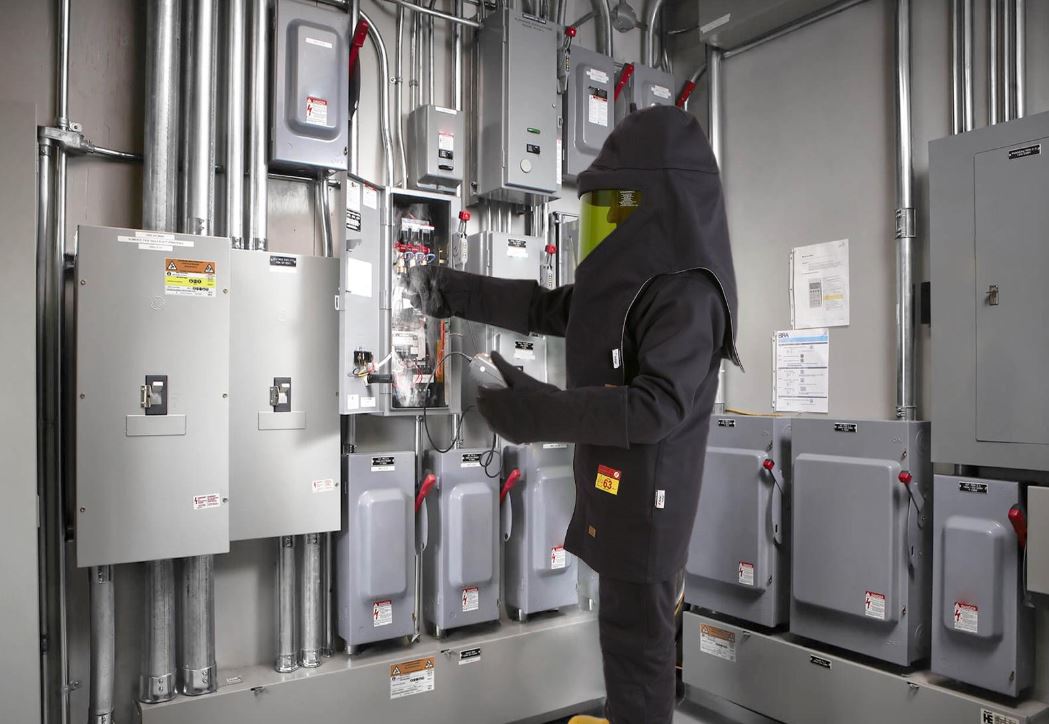Protection Against Electric Arc Hazards
Sponsored Article by Guardup Asia
What is an electric arc?
Arc originates from gas ionization, electrodes at different potentials are the conductive electrical connection between different phases. An electric arc can occur due to a technical or operator error. While galvanic contacts are required to trigger the electric arc in low-voltage areas and high-voltage areas, live parts may be caused by an inconvenience in the relative distance.
An electric arc explosion is a very short-term electricity flow or discharges in the form of heat and light through the air between two conductors that do not touch each other along an unintended path.
IEEE Std 100-1988 defines electric arc as a discharge of electricity through a gas, normally characterized by a voltage drop near the cathode approximately equal to the ionization potential of the gas and flashover as:
- (general) a disruptive discharge through the air around or over the surface of solid or liquid insulation, between parts of different potential or polarity, produced by the application of voltage wherein the breakdown path becomes sufficiently ionized to maintain an electric arc.
- (high voltage ac cable termination) A disruptive discharge around or over the surface of an insulating member, between parts of different potential or polarity, produced by the application of voltage wherein the breakdown path becomes sufficiently ionized to maintain an electric arc.
- (high voltage testing) Term used when a disruptive discharge occurs over the surface of a solid dielectric in a gaseous or liquid medium.
Air is not a good conductor, most of the current flows are through post-arc vapor (usually copper and aluminum vapor) and ionized particles in the air. This mixture at a very high temperature is called plasma.
Effects of electric arc
Depending on the power and burning time of the electric arc, different physical effects can be seen due to the high temperature. Electric arc energy is discharged in multiple ways, such as electrical, thermal, mechanical, photonic, or luminous energy. Mechanical energy usually occurs in the form of explosions. Many various factors affect the energy created by an electric arc (See; Factors affecting the damage of electric arc).
According to NFPA 921 Sections 14-1 and 14-9 through 14-12.2 Electricity and Fire, an arc is a high-temperature luminous electric discharge across a gap. Temperatures within the arc are in the range of several thousand degrees depending on circumstances including current, voltage drop, and metal involved. For an arc to jump even the smallest air gap spontaneously, there must be a voltage difference of at least 350 V. In the 120/240-V systems being considered here, arcs do not form spontaneously under normal circumstances. Despite the very high temperatures in an arc path, arcs may not be competent ignition sources for many fuels. In most cases, the arcing is so brief and localized that solid fuels such as wood structural members cannot be ignited. Fuels with a high surface-area-to-mass ratio, such as cotton batting and tissue paper and combustible gases and vapors, may be ignited when in contact with the arc.
Temperature
According to NFPA 921 Sections 14-1 and 14-9 through 14-12.2 Electricity and Fire, for ignition to be from an electrical source, the following must occur:
- The electrical wiring, equipment, or component must have been energized from a building's wiring, an emergency system, a battery, or some other source.
- Sufficient heat and temperature to ignite a close combustible material must have been produced by electrical energy at the point of origin by the electrical source.
The arcs can exceed over 10,000 °F and electrical fires are likely the outcome of these arc flashes. The material in the center of the arc evaporates and causes a conductive connection between the electrodes. The fact that the tip of a burning cigarette is 580 °C when not smoked, 700 °C when smoking, and the surface temperature of the sun at 6,000 °C reveals how dangerous arc explosions are. The temperature effect of an arc blast with a diameter of 20 cm at a distance of 50 cm is approximately 1300 °C.
As the condensed heat increases during the arc blast, a plasma is formed between the electrodes. Plasma separates due to the separation and ionization of all other chemical components. After the metal has evaporated, a very high-temperature rise occurs and the explosive metal vapor and splashes cause mass expansion towards the center of the arc. As a result of cooling and after reaction with oxygen in the atmosphere, the metal oxide can be found as black or gray smoke. Because the steam or fumes have enough heat, they leave a sticky waste.
The following result comes from the experimental studies carried out by IEEE (Institute of Electrical and Electronics Engineers); Arc-induced heat energy can kill or injure people even from great distances. For example, it can cause 2nd-degree burns from a distance of 3.6 m. A second-degree burn is called for the increase in heat energy of 1.2 cal/cm² on the skin in 1 second (threshold value).
Depending on the intensity of the electric arc, heat radiation can also ignite flammable materials around it. Molten metal splashes that may occur increasing the risk of fire. Also, workers in hazardous areas exposed to toxic erosion from the electric arc can suffer severe lung damage, apart from burning on the skin.
Arc blast causes burns to the point of death. The causes of accidents that the vast majority of those who go to hospitals due to electrical accidents are exposed to are not electric shock, 80% of them are electric arc accidents. Most of the high-grade burns and deaths resulting from these accidents are caused by the ignition and burning of clothes or underwear that are not resistant to heat and flame.
Mechanical
Another physical reaction during the development of an electric arc is the formation of a huge pressure wave of up to 0.3 MPa between the duration of 5-15 ms. This corresponds to a pressure of 20-30 t/m2. The effect of a 22 kA electric arc explosion at a distance of 60 cm will be 225 kg. If continuous pressure wave transmission does not occur, it risks destroying electrical equipment and those around it. Doors and coatings may burst, and pipes and equipment may rupture.
Noise
Noise pressure levels of up to 160 dB can be reached by an electric arc blast. This is a level that can make human deaf. To give an example, the noise of a jet engine at a distance of 30 m is 140 dB.
Flash
It is very dangerous for the eyes as it may cause blindness. If the energy is too high, it may cause ultraviolet burns. For protection, arc flash protective visors (face shields) or hoods with visors that are dark enough not to damage the eyes in the event of a blast and certified according to the relevant standards should be used.
Interior of a medium-voltage cubicle showing the results of an electrical arc and accompanying electrical blast; external view of an aisle and adjacent switchgear for arc flash event shown below. Workers may not assume that they are safe from electric arc flash events even though the access doors and panels are fully secured. Unless it is specially designed arc flash protective clothing, metal-clad equipment will probably not withstand the explosive force of an electric arc blast.
Factors affecting the damage of electric arc
Distance – The magnitude of the damage decreases approximately with the square of the distance to the electric arc. In other words, doubling the distance reduces the damage 4 times (may vary depending on the environment).
Temperature – There is a ratio between the difference between the 4th exponent of the arc temperature and the 4th exponent of the body temperature and the energy is taken.
Absorption Coefficient – It is the ratio between the energy incoming to the body and the energy received by the body.
Exposure Time – As the exposure time increases, the energy is taken increases.
Body Area Exposed to Electric Arc – The larger the body area exposed to electric arc, the more energy absorbed. Calculation of hazard energy level is specified as kJ/m2, J/cm2, cal/cm2.
Direction Angle – The angle of hit and the energy taken are proportional. It is exposed to the most energy when it is hit at an angle of 90 degrees.
Electric arc-related hazards
There are a lot of hazards that may be occurred from an arc flash such as thermal burns, burst pressure wave injury, hearing loss, harmful electromagnetic emissions, emission of highly toxic gases, shrapnel injury (blast). An arc flash can cause fatal physical injuries. When the skin is severely burnt, large quantities of liquid are brought to the burnt areas to aid in the healing process. This creates stress on the renal system and could result in kidney failure. Severe trauma from massive burns can cause a general systemic failure. Burnt internal organs can shut
down—causing death. Thus, the more critical the organ that is burnt, the higher the possibility of death. The pressure front from the blast can cause severe injury to the lungs, called blast-lung, resulting in death. Heart failure can result from fibrillation and/or paralysis.
Arc flash protective clothing
Preventing clothing and underwear from ignition often ensures survival. Limiting burns to a small surface area provides better results. Prevention of all burns is of course the best option, however, it is also very important to survive an accident with non-fatal burns of various sizes. Protective equipment must be used for this reason. Clothing made of acetate, nylon, polyester, silk or their mixture should never be worn in hazardous workplaces. In environments where there is a risk of burning, clothing and/or underwear made of flame retardant fabrics should be
used. Flame retardant fabrics are divided into two according to the production technique.
Finished fabrics with chemical FR treatment
Fabrics, such as cotton, cotton/polyester blends, cotton/polyamide blends, whose flame is delayed by various chemical treatments, do not lose their flame retardant properties until a certain wash. When washing by the manufacturer's instructions, there are flame resistant fabrics up to 30-50-100-150 washes, depending on the process applied.
Inherently flame retardant fabrics
Fabrics produced from various fibers such as meta-aramid or para-aramid, viscose FR are inherently flame retardant. Even if washed many times, they never lose their flame-resistant properties. However, they are technical fabrics with higher costs compared to finished fabrics.

All of our ELECTPRO® series electric arc flash protective suits produced by our company, IST Safety Ltd are manufactured by the latest (EU) 2016/425 PPE regulation and have EU type-examination certificates and passed the relevant tests of IEC 61482 standard.
ELECTPRO® G2L ULTRASOFT 900 High Energy Electric Arc Flash Protective Suit which has been launched by our company protects the user's body against the negative effects of electric arc such as heat, flame, molten particles. The protective hood is certified according to GS ET 29 standard and carries the CE mark. The visor of the hood is dark enough to protect the eyes from the flash. A protective suit consists of three parts as a jacket, bib, trousers, and hood with visor, and all of them are made double-layered. The suit is Class 2 (7 kA) according to IEC 61482 1-2
standard. According to the IEC 61482 1-1 standard, the ATPV value of the suit and the whole layer system is 63 cal / cm2.
References:
Electrical Safety Handbook by Dennis K. Neitzel, Mary Capelli-Schellpfeffer, Al Winfield
IEEE Std 100-1988 Standard Dictionary of Electrical and Electronics Terms
NFPA 921 Sections 14-1 and 14-9 through 14-12.2 Electricity and Fire
IEC International Electrotechnical Commission Website
ASTM International Website

